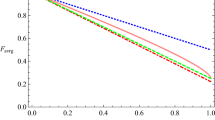Abstract
Quantum-dot cellular automata (QCA) represent an alternative technology for implementing various computations and high-performance, low-power consumption digital circuits at nanoscale. Meanwhile, an universal shift register (USR) with guaranteed free position shift and parallel input and transfer of the stored bit value of the register is an essential element in the design of the circuit. Therefore, we propose an USR circuit based on QCA (QUSR) which can be configured by combining the shift register with a multiplexer (Mux) to select the function of the register. In this study, we propose a 2-to-1 Mux based on the electronic correlations between the cells, and then extend this to a 4-to-1 Mux. We also propose a new D flip-flop, and design a shift register by connecting these. Finally, we propose a QUSR with an extremely optimized area and latency, by connecting four 4-to-1 Muxes and a four-bit shift register. The proposed QUSR is highly efficient, in terms of the space, time complexity and energy dissipation. All proposed structures are simulated by QCADesigner to demonstrate the clarity of the motion and efficiency. We also measured and compared the energy dissipation in three tunneling levels by QCAPro.


















Similar content being viewed by others
References
Moore GE (1965) Cramming more components onto integrated circuits. Electronics 38(2):114–117
Jeon JC (2015) Extendable quantum-dot cellular automata decoding architecture using 5-input majority gate. Int J Control Autom 8(12):107–118
Lent CS, Tougaw PD, Porod W, Bernstein GH (1993) Quantum cellular automata. Nanotechnology 4(1):49–57
Sabbaghi-Nadooshan R, Kianpour M (2014) A novel QCA implementation of MUX-based universal shift register. J Comput Electron 13(1):198–210
Purkayastha T, De D, Chattopadhyay T (2018) Universal shift register implementation using quantum dot cellular automata. Ain Shams Eng J 9:291–310
Ahmad F (2018) An optimal design of QCA based 2n:1/1:2n multiplexer/demultiplexer and its efficient digital logic realization. Microprocess Microsyst 56:64–75
Mardiris VA, Karafyllidis IG (2009) Design and simulation of modular 2 to 1 quantum-dot cellular automata (QCA) multiplexers. Int J Circuit Theory Appl 38(8):771–785
Hashemi S, Navi K (2012) New robust QCA D flip flop and memory structures. Microelectron J 43(12):929–940
Roohi A, Khademolhosseini H, Sayedsalehi S, Navi K (2011) A novel architecture for quantum-dot cellular automata multiplexer. Int J Comput Sci 8(6):55–60
Sen B, Goswami M, Mazumdar S, Sikdar BK (2015) Towards modular design of reliable quantum-dot cellular automata logic circuit using multiplexers. Comput Electron Eng 45:42–54
Das JC, De DD (2016) Optimized multiplexer design and simulation using quantum dotcellular automata. Indian J Pure Appl Phys 54:802–811
Das JC, De D (2016) Shannon’s expansion theorem-based multiplexer synthesis using QCA. Nanomater Energy 5:53–60
Singh S, Pandey S, Wairya S (2016) Modular design of 2n:1 quantum dot cellular automata multiplexers and its application, via clock zone based crossover. Int J Modern Educ Comput Sci 7:41–52
Mustafa M, Beigh MR (2014) Novel linear feedback shift register design in quantum-dot cellular automata. Indian J Pure Appl Phys 52(3):203–209
You YW, Jeon JC (2017) QCA D flip-flop with high scalability using multilayer structure. Adv Sci Lett 23(10):9841–9846
Jeon JC (2017) Analysis of coplanar QCA decoder module using typical five input majority gate. Adv Sci Lett 23(10):9847–9851
Lee JS, Jeon JC (2017) Design and simulation of novel D flip-flop based sequential logic circuits in QCA. Adv Sci Lett 23(10):10102–10106
Safoev N, Jeon JC (2019) Implementation of high-speed shifting operation in quantum-dot cellular automata technology. Int J Mech Eng Technol 10(2):576–586
Angizi S, Sarmadi S, Sayedsalehi S, Navi K (2015) Design and evaluation of new majority gate-based RAM cell in quantum-dot cellular automata. Microelectron J 46(1):43–51
Lee JS, Jeon JC (2016) Design of low hardware complexity multiplexer using NAND Gates on quantum-dot cellular automata. Int J Multimed Ubiquitous Eng 11(12):307–318
Makanda K, Jeon JC (2015) Reinforced secure secret sharing for quantum communication. Int Inf Inst 18(10):4289–4296
Jeon JC (2016) Low hardware complexity QCA decoding architecture using inverter chain. Int J Control Autom 9(4):347–358
Jeon JC (2019) Minimized energy consumption based QCA reversible adder. Int J Civ Eng Technol 10(2):702–714
Roohi A, DeMara RF, Khoshavi N (2015) Design and evaluation of an ultra-area-efficient fault-tolerant QCA full adder. Microelectron J 46(6):531–542
Erniyazov S, Jeon JC (2019) Carry save adder and carry look ahead adder using inverter chain based coplanar QCA full adder for low energy dissipation. Microelectron Eng 211:37–43
Srivastava S, Asthana A, Bhanja S, Sarkar S (2011) QCAPro-an error power estimation tool for QCA circuit design. In: Proceedings of the IEEE international symposium circuits system. pp 2377–2380
Srivastava S, Sarkar S, Bhanja S (2009) Estimation of upper bound of power dissipation in QCA circuits. IEEE Trans Nanotechnol 8:116–127
Blair EP, Yost E, Lent CS (2010) Power dissipation in clocking wires for clocked molecular quantum-dot cellular automata. J Comput Electron 9:49–55
Erniyazov S, Jeon JC (2019) Low power consumption Quantum-dot cellular automata (QCA) magnitude comparator with single layer wire-crossing technique. Asia Life Sci 18(3):1471–1478
Acknowledgements
This paper was supported by Kumoh National Institute of Technology.
Author information
Authors and Affiliations
Corresponding author
Additional information
Publisher's Note
Springer Nature remains neutral with regard to jurisdictional claims in published maps and institutional affiliations.
Rights and permissions
About this article
Cite this article
Jeon, JC. Low-complexity QCA universal shift register design using multiplexer and D flip-flop based on electronic correlations. J Supercomput 76, 6438–6452 (2020). https://doi.org/10.1007/s11227-019-02962-y
Published:
Issue Date:
DOI: https://doi.org/10.1007/s11227-019-02962-y




